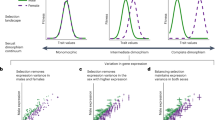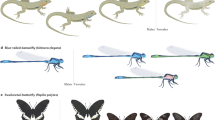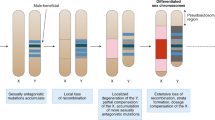Key Points
-
Sexual dimorphism, or the morphological and behavioural differentiation of the two sexes of the same species, is widespread in nature.
-
Sex-limited traits are the product of sex-limited gene expression.
-
Although the mechanisms that initiate sexually dimorphic development are remarkably diverse, these pathways generally converge upon more conserved genetic components.
-
Gene cis-regulatory elements that possess binding sites for both sex- and tissue-specific transcription factors function as sexually dimorphic genetic switches in pathways for sexually dimorphic traits.
-
Effectors of the sexual differentiation pathway that are expressed specifically in the neural region can collaborate with other factors to generate sexually dimorphic neural morphology and hence behaviour.
-
New patterns of sex-limited gene expression and traits can evolve by the modification of ancestral cis-regulatory elements that control other dimorphic traits.
-
The gain and loss of binding sites for the transcriptional effectors of sexual differentiation pathways in cis-regulatory elements can result in the transition between sexually dimorphic and monomorphic gene expression.
-
The evolution of sexually dimorphic cis-regulatory elements in genes explains how the development of the two sexes can become uncoupled and allow for the independent evolution of traits between the sexes.
-
Evolutionary-developmental biologists have shown how sexually dimorphic traits arise, and ecologists have shown the importance of such traits in nature. An important future goal is to bridge the findings of these two disciplines.
Abstract
Sexual dimorphism is common throughout the animal kingdom. However, a molecular understanding of how sex-specific traits develop and evolve has been elusive. Recently, substantial progress has been made in elucidating how diverse sex-determination systems are integrated into developmental gene networks. One common theme from these studies is that sex-limited traits and gene expression are produced by the combined action of transcriptional effectors of sex-determination pathways and other transcription factors on target gene cis-regulatory elements. Sex-specific traits evolve by the gain, loss or modification of linkages in the genetic networks regulated by sex-determination transcription factors.
This is a preview of subscription content, access via your institution
Access options
Subscribe to this journal
Receive 12 print issues and online access
$189.00 per year
only $15.75 per issue
Buy this article
- Purchase on Springer Link
- Instant access to full article PDF
Prices may be subject to local taxes which are calculated during checkout




Similar content being viewed by others
References
Judson, O. Dr Tatiana's Sex Advice to All Creation (Holt Paperbacks, New York, 2002).
Andersson, M. Sexual Selection (Princeton Univ. Press, 1994).
Temeles, E. J., Pan, I. L., Brennan, J. L. & Horwitt, J. N. Evidence for ecological causation of sexual dimorphism in a hummingbird. Science 289, 441–443 (2000).
Marin, I. & Baker, B. S. The evolutionary dynamics of sex determination. Science 281, 1990–1994 (1998).
Wilkins, A. S. Moving up the hierarchy: a hypothesis on the evolution of a genetic sex determination pathway. Bioessays 17, 71–77 (1995).
Schartl, M. Sex chromosome evolution in non-mammalian vertebrates. Curr. Opin. Genet. Dev. 14, 634–641 (2004).
Haag, E. S. The evolution of nematode sex determination: C. elegans as a reference point for comparative biology. WormBook [online], (2005).
Cline, T. W. & Meyer, B. J. Vive la difference: males vs females in flies vs worms. Annu. Rev. Genet. 30, 637–702 (1996).
Berta, P. et al. Genetic evidence equating SRY and the testis-determining factor. Nature 348, 448–450 (1990).
Jager, R. J., Anvret, M., Hall, K. & Scherer, G. A human XY female with a frame shift mutation in the candidate testis-determining gene SRY. Nature 348, 452–454 (1990).
Koopman, P., Gubbay, J., Vivian, N., Goodfellow, P. & Lovell-Badge, R. Male development of chromosomally female mice transgenic for Sry. Nature 351, 117–121 (1991).
Beye, M. The dice of fate: the csd gene and how its allelic composition regulates sexual development in the honey bee, Apis mellifera. Bioessays 26, 1131–1139 (2004).
Beye, M., Hasselmann, M., Fondrk, M. K., Page, R. E. & Omholt, S. W. The gene csd is the primary signal for sexual development in the honeybee and encodes an SR-type protein. Cell 114, 419–429 (2003).
Hasselmann, M. et al. Evidence for the evolutionary nascence of a novel sex determination pathway in honeybees. Nature 454, 519–522 (2008). This paper showed that the newly evolved csd gene, which governs honeybee sex-determination, regulates the sex-specific splicing of the fem gene, a functional homologue of the tra gene of the fruitfly sex-differentiation pathway. It demonstrates how a distinct mechanism that initiates sex determination can converge upon evolutionarily conserved genes.
Cho, S., Huang, Z. Y. & Zhang, J. Sex-specific splicing of the honeybee doublesex gene reveals 300 million years of evolution at the bottom of the insect sex-determination pathway. Genetics 177, 1733–1741 (2007).
Zarkower, D. Somatic sex determination. WormBook [online], (2006).
Zarkower, D. & Hodgkin, J. Molecular analysis of the C. elegans sex-determining gene tra-1: a gene encoding two zinc finger proteins. Cell 70, 237–249 (1992).
Starostina, N. G. et al. A CUL-2 ubiquitin ligase containing three FEM proteins degrades TRA-1 to regulate C. elegans sex determination. Dev. Cell 13, 127–139 (2007).
Schvarzstein, M. & Spence, A. M. The C. elegans sex-determining GLI protein TRA-1A is regulated by sex-specific proteolysis. Dev. Cell 11, 733–40 (2006).
Sekido, R. & Lovell-Badge, R. Sex determination and SRY: down to a wink and a nudge? Trends Genet. 25, 19–29 (2009).
Ferguson-Smith, M. The evolution of sex chromosomes and sex determination in vertebrates and the key role of DMRT1. Sex Dev. 1, 2–11 (2007).
Nanda, S. et al. Sox100B, a Drosophila group E Sox-domain gene, is required for somatic testis differentiation. Sex Dev. 3, 126–137 (2009).
Smith, C. A. et al. The avian Z-linked gene DMRT1 is required for male sex determination in the chicken. Nature 461, 267–271 (2009).
Yoshimoto, S. et al. A W-linked DM-domain gene, DM-W, participates in primary ovary development in Xenopus laevis. Proc. Natl Acad. Sci. USA 105, 2469–2474 (2008).
Zarkower, D. Establishing sexual dimorphism: conservation amidst diversity? Nature Rev. Genet. 2, 175–185 (2001).
Matsuda, M. et al. DMY is a Y-specific DM-domain gene required for male development in the medaka fish. Nature 417, 559–563 (2002).
Arango, N. A., Lovell-Badge, R. & Behringer, R. R. Targeted mutagenesis of the endogenous mouse Mis gene promoter: in vivo definition of genetic pathways of vertebrate sexual development. Cell 99, 409–419 (1999).
Wilhelm, D. et al. SOX9 regulates prostaglandin D synthase gene transcription in vivo to ensure testis development. J. Biol. Chem. 282, 10553–10560 (2007).
Sekido, R. & Lovell-Badge, R. Sex determination involves synergistic action of SRY and SF1 on a specific Sox9 enhancer. Nature 453, 930–934 (2008). This paper showed that the upregulation of Sox9 gene expression, a key step in the initiation of testis development, occurs by the binding of the testis-determining factor SRY and the orphan nuclear receptor SF1 proteins to a Sox9 CRE.
O'Lone, R., Frith, M. C., Karlsson, E. K. & Hansen, U. Genomic targets of nuclear estrogen receptors. Mol. Endocrinol. 18, 1859–1875 (2004).
Notini, A. J., Davey, R. A., McManus, J. F., Bate, K. L. & Zajac, J. D. Genomic actions of the androgen receptor are required for normal male sexual differentiation in a mouse model. J. Mol. Endocrinol. 35, 547–555 (2005).
Massie, C. E. et al. New androgen receptor genomic targets show an interaction with the ETS1 transcription factor. EMBO Rep. 8, 871–878 (2007).
Robins, D. M. Multiple mechanisms of male-specific gene expression: lessons from the mouse sex-limited protein (Slp) gene. Prog. Nucleic Acid Res. Mol. Biol. 78, 1–36 (2004).
Seiler-Tuyns, A. et al. Identification of estrogen-responsive DNA sequences by transient expression experiments in a human breast cancer cell line. Nucleic Acids Res. 14, 8755–8770 (1986).
Cardinaux, J. R., Chapel, S. & Wahli, W. Complex organization of CTF/NF-I, C/EBP, and HNF3 binding sites within the promoter of the liver-specific vitellogenin gene. J. Biol. Chem. 269, 32947–32956 (1994).
Mason, D. A., Rabinowitz, J. S. & Portman, D. S. dmd-3, a doublesex-related gene regulated by tra-1, governs sex-specific morphogenesis in C. elegans. Development 135, 2373–2382 (2008). The authors found that the dmd-3 gene, a homologue of genes that function in sexual differentiation in diverse taxa, is essential for the proper development of the C. elegans male tail morphology. They showed that a CRE adjacent to dmd-3 integrates region-specific and sex-specific transcription factor inputs to limit dmd-3 expression to male tail cells.
Peden, E., Kimberly, E., Gengyo-Ando, K., Mitani, S. & Xue, D. Control of sex-specific apoptosis in C. elegans by the BarH homeodomain protein CEH-30 and the transcriptional repressor UNC-37/Groucho. Genes Dev. 21, 3195–3207 (2007).
Conradt, B. & Horvitz, H. R. The TRA-1A sex determination protein of C. elegans regulates sexually dimorphic cell deaths by repressing the egl-1 cell death activator gene. Cell 98, 317–327 (1999).
Yi, W., Ross, J. M. & Zarkower, D. Mab-3 is a direct tra-1 target gene regulating diverse aspects of C. elegans male sexual development and behavior. Development 127, 4469–4480 (2000).
Williams, T. M. et al. The regulation and evolution of a genetic switch controlling sexually dimorphic traits in Drosophila. Cell 134, 610–623 (2008). The paper showed how one CRE integrates sex- and region-specific transcription factors to control sexually dimorphic gene expression and traits. The authors found that a new dimorphic trait evolved by the modification of an ancestrally dimorphic CRE that controlled other dimorphic traits.
Coschigano, K. T. & Wensink, P. C. Sex-specific transcriptional regulation by the male and female doublesex proteins of Drosophila. Genes Dev. 7, 42–54 (1993).
Shirangi, T., Dufour, H., Williams, T. M. & Carroll, S. B. Rapid evolution of sex pheromone-producing enzyme expression in Drosophila. PLoS Biol. 7, e1000168 (2009). The authors show that transitions between sexually monomorphic and dimorphic gene expression patterns, and hence traits, can occur by the gain and loss of binding sites for the effector of the sex-determination pathway.
Hall, J. C. Control of male reproductive behavior by the central nervous system of Drosophila: dissection of a courtship pathway by genetic mosaics. Genetics 92, 437–457 (1979).
Tompkins, L. & Hall, J. C. Identification of brain sites controlling female receptivity in mosaics of Drosophila melanogaster. Genetics 103, 179–195 (1983).
Billeter, J. C., Rideout, E. J., Dornan, A. J. & Goodwin, S. F. Control of male sexual behavior in Drosophila by the sex determination pathway. Curr. Biol. 16, R766–R776 (2006).
Kimura, K., Hachiya, T., Koganezawa, M., Tazawa, T. & Yamamoto, D. Fruitless and doublesex coordinate to generate male-specific neurons that can initiate courtship. Neuron 59, 759–769 (2008). The authors found a sexually dimorphic neuronal cluster in D. melanogaster that functions in the initiation of courtship by males. The presence, morphology and function of this cluster are governed in large part by the activity of the sex-specific isoforms of the fruitfly sex-determination pathway effectors.
Datta, S. R. et al. The Drosophila pheromone cVA activates a sexually dimorphic neural circuit. Nature 452, 473–477 (2008).
Rideout, E. J., Billeter, J. C. & Goodwin, S. F. The sex-determination genes fruitless and doublesex specify a neural substrate required for courtship song. Curr. Biol. 17, 1473–1478 (2007).
Darwin, C. The Descent of Man, and Selection in Relation to Sex (John Murray, London, 1871).
Ng, C. S. & Kopp, A. Sex combs are important for male mating success in Drosophila melanogaster. Behav. Genet. 38, 195–201 (2008).
Cook, R. M. Behavioral role of the sexcombs in Drosophila melanogaster and Drosophila simulans. Behav. Genet. 7, 349–357 (1977).
Tanaka, K., Barmina, O. & Kopp, A. Distinct developmental mechanisms underlie the evolutionary diversification of Drosophila sex combs. Proc. Natl Acad. Sci. USA 106, 4764–4769 (2009).
Barmina, O. & Kopp, A. Sex-specific expression of a HOX gene associated with rapid morphological evolution. Dev. Biol. 311, 277–286 (2007).
Struhl, G. Genes controlling segmental specification in the Drosophila thorax. Proc. Natl Acad. Sci. USA 79, 7380–7384 (1982).
Ferveur, J. F. Cuticular hydrocarbons: their evolution and roles in Drosophila pheromonal communication. Behav. Genet. 35, 279–295 (2005).
Chertemps, T., Duportets, L., Labeur, C., Ueyama, M. & Wicker-Thomas, C. A female-specific desaturase gene responsible for diene hydrocarbon biosynthesis and courtship behaviour in Drosophila melanogaster. Insect Mol. Biol. 15, 465–473 (2006).
Jeong, S., Rokas, A. & Carroll, S. B. Regulation of body pigmentation by the Abdominal-B Hox protein and its gain and loss in Drosophila evolution. Cell 125, 1387–1399 (2006).
Fisher, R. A. The Genetical Theory of Natural Selection (Clarendon Press, Oxford, 1930).
Bonduriansky, R. & Chenoweth, S. F. Intralocus sexual conflict. Trends Ecol. Evol. 24, 280–288 (2009).
Lande, R. Sexual dimorphism, sexual selection, and adaptation in polygenic characters. Evolution 34, 292–305 (1980).
Carroll, S. B. Evo-devo and an expanding evolutionary synthesis: a genetic theory of morphological evolution. Cell 134, 25–36 (2008).
Sinervo, B., Miles, D. B., Frankino, W. A., Klukowski, M. & DeNardo, D. F. Testosterone, endurance, and Darwinian fitness: natural and sexual selection on the physiological bases of alternative male behaviors in side-blotched lizards. Horm. Behav. 38, 222–233 (2000).
Boughman, J. W. Condition-dependent expression of red colour differs between stickleback species. J. Evol. Biol. 20, 1577–1590 (2007).
Zauner, H., Begemann, G., Mari-Beffa, M. & Meyer, A. Differential regulation of msx genes in the development of the gonopodium, an intromittent organ, and of the 'sword', a sexually selected trait of swordtail fishes (Xiphophorus). Evol. Dev. 5, 466–477 (2003).
Warren, I. & Smith, H. Stalk-eyed flies (Diopsidae): modelling the evolution and development of an exaggerated sexual trait. Bioessays 29, 300–307 (2007).
Moczek, A. P. & Rose, D. J. Differential recruitment of limb patterning genes during development and diversification of beetle horns. Proc. Natl Acad. Sci. USA 106, 8992–8997 (2009).
Acknowledgements
We thank three anonymous referees for their thoughtful critiques and suggestions to improve this manuscript. We are grateful to the following individuals for granting permission to use the images in figure 1: A. Wild, K. Lu, T. Bartlett, M. K. Meyer and C. Lambert. S.B.C. acknowledges research support from the Howard Hughes Medical Institute.
Author information
Authors and Affiliations
Corresponding author
Related links
Related links
DATABASES
FlyBase
WormBase
FURTHER INFORMATION
Glossary
- Sexually dimorphic traits
-
Any difference between males and females/hermaphrodites in appearance, cellular chemistry or behaviour.
- Sex-limited gene expression
-
Any differences in the overall expression profile of a gene between males and females/hermaphrodites.
- Cis-regulatory element
-
A discrete region of DNA adjacent to a gene that affects the expression level of the gene.
- Heteromorphic sex chromosomes
-
Chromosomes that differ in appearance and gene content, are unequally shared between the sexes and function in sex determination.
- Genetic balance
-
A mechanism of sex determination in which the quantity or dose of a particular sex chromosome rather than the content determines the sex of a zygote.
- Hedgehog signalling
-
The hedgehog proteins are a class of secreted cell–cell signalling molecule. The name derives from the appearance of embryonic Drosophila melanogaster mutants that lack hedgehog gene function. There are many vertebrate genes that encode hedgehog homologues.
- Bipotential gonad
-
The last embryonic tissue precursor that can differentiate into either the ovary or the testis.
- Monotremes
-
Non-eutherian, egg-laying mammals.
- Sertoli cell
-
A cell in the testis that secretes factors, including Müllerian inhibiting substance, and provides nourishment to early sperm cells.
- Oviparous
-
Animals that reproduce by laying eggs that develop and hatch outside the mother's body.
- Wattle
-
A fleshy coloured fold of skin hanging from the neck or throat of certain bird species.
- Oenocytes
-
Specialized cells that lie underneath the dorsal and ventral cuticle of adult fruitfly abdomens. They are arranged in metameric transverse stripes that do not cross the midline of the body.
- Mesothoracic ganglion
-
Part of the central nervous system that supplies motor neurons to the wing muscles of the mesothoracic segment.
- Homeobox gene
-
A member of the family of genes that are largely involved in patterning the primary animal body axis during development. In many species, homeobox genes are clustered together on defined chromosomes and are often sequentially expressed.
- Fitness
-
A quantity that is proportional to the mean number of viable, fertile progeny produced by a genotype.
- Pleiotropic
-
The phenomenon by which a single gene is responsible for several distinct and seemingly unrelated phenotypic effects.
Rights and permissions
About this article
Cite this article
Williams, T., Carroll, S. Genetic and molecular insights into the development and evolution of sexual dimorphism. Nat Rev Genet 10, 797–804 (2009). https://doi.org/10.1038/nrg2687
Issue Date:
DOI: https://doi.org/10.1038/nrg2687
This article is cited by
-
The X-factor in ART: does the use of assisted reproductive technologies influence DNA methylation on the X chromosome?
Human Genomics (2023)
-
The function and evolution of a genetic switch controlling sexually dimorphic eye differentiation in honeybees
Nature Communications (2023)
-
Evolutionary differentiation of androgen receptor is responsible for sexual characteristic development in a teleost fish
Nature Communications (2023)
-
Eighty million years of rapid evolution of the primate Y chromosome
Nature Ecology & Evolution (2023)
-
The evolution of sexual dimorphism in Chondrichthyes: drivers, uncertainties, and future directions
Environmental Biology of Fishes (2023)



